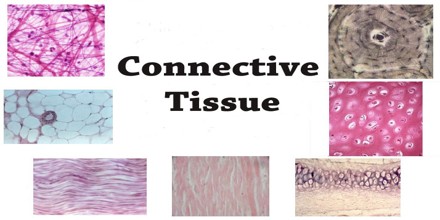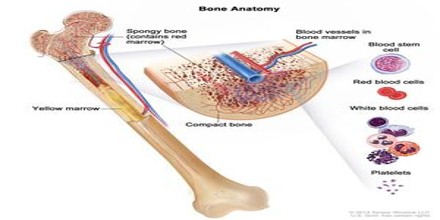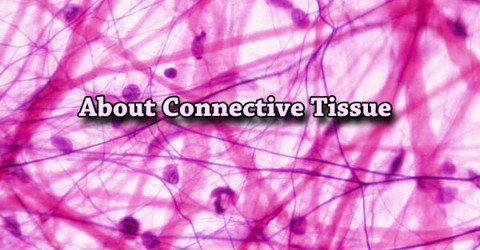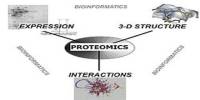About Connective Tissue
Definition
Connective Tissue (or CT) is a group of tissues in the body that maintain the form of the body and its organs and provide cohesion and internal support. The connective tissues include several types of fibrous tissue that vary only in their density and cellularity, as well as the more specialized and recognizable variants—bone, ligaments, tendons, cartilage, and adipose (fat) tissue.

Connective Tissue is distinguished from the other types in that the extracellular material (matrix) usually occupies more space than the cells do, and the cells are relatively far apart. The matrix of connective tissue typically consists of fibers and a featureless ground substance. The most abundant fiber in connective tissues is a tough protein called collagen. Tendons, ligaments, and the white stringy tissue (fascia) seen in some cuts of meat are composed almost entirely of collagen, as is leather, which consists of the connective tissue layer (dermis) of animal skins. Collagen also strengthens bone and cartilage. Elastic and reticular fibers are less abundant connective tissue proteins with a more limited distribution.
All connective tissue consists of three main components: fibers (elastic and collagenous fibers), ground substance and cells. Not all authorities include blood or lymph as connective tissue. Blood and lymph lack the fiber component. All are immersed in the body water. The cells of connective tissue include fibroblasts, adipocytes, macrophages, mast cells and leucocytes.
Structure of Connective Tissue
Connective Tissue is composed primarily of two elements: cells and a matrix. The types of cells found in connective tissue vary depending on the type of tissue they support. For example, red and white blood cells are found in blood, which is a fluid connective tissue. Adipocytes are fat cells found in adipose tissue, or fat. And fibroblasts are cells found in large quantities in many different types of connective tissues.

The matrix can be thought of as the substance in which the cells are embedded. The matrix can be fluid, semifluid, gelatinous, or ground substance and protein fibers. One very basic way to visualize this is to imagine Jell-O with chunks of fruit in it. Jell-O is the matrix, and the fruit represents cells. A ground substance is a supportive medium made of water and large molecules. There are three types of protein fibers found within the matrix. Collagen fibers are very strong and provide flexibility. Elastic fibers are very stretchy and assume their original shape after being stretched. Finally, reticular fibers are very thin and provide support for many soft organs and blood vessels.
Functions and Types of Connective Tissue
Connective Tissue (CT) has a wide variety of functions that depend on the types of cells and the different classes of fibers involved. Loose and dense irregular connective tissue, formed mainly by fibroblasts and collagen fibers, have an important role in providing a medium for oxygen and nutrients to diffuse from capillaries to cells, and carbon dioxide and waste substances to diffuse from cells back into circulation. They also allow organs to resist stretching and tearing forces. Dense regular connective tissue, which forms organized structures, is a major functional component of tendons, ligaments and aponeuroses, and is also found in highly specialized organs such as the cornea. Elastic fibers, made from elastin and fibrillin, also provide resistance to stretch forces. They are found in the walls of large blood vessels and in certain ligaments, particularly in the ligamenta flava.

Connective Tissue in the body comes in a variety of forms. In fetuses and embryos, we find embryonic connective tissue. Past the point of birth, there is mature connective tissue. There are six major types of mature connective tissue.
Loose Connective Tissue: In this type, fibers are loosely entwined with many cells embedded. Adipose, or fat tissue, is an example of loose connective tissue. The subcutaneous tissue, or innermost layer of skin, is made up of adipose tissue, as well as areolar tissue, another loose connective tissue.
Dense Connective Tissue: It has thicker, denser fibers and fewer cells. The matrix is made up mostly of collagen fibers, with fibroblasts arranged in rows. This type of connective tissue forms tendons and ligaments, which attach muscle to bone and bone to bone, respectively.
Cartilage: It is the third type of connective tissue. Many of us are familiar with this flexible tissue that makes up our nose and ears. Cartilage is strong due to the collagen fibers within its matrix, and it is resilient due to a gel matrix. Cartilage is also found in the body as a cushion within the skeletal system.
Bones: Bones are a fourth example of connective tissue. Bones are made up of different types of connective tissue, including bone tissue and marrow. Bone tissue is either spongy or compact depending on the organization of the cells and matrix.

Adipose tissue (fat): Large fat-filled adipocytes and scanty extracellular matrix. Stores energy, conserves body heat, cushions and protects many organs, fills space, shapes body.
Blood: It is a type of fluid connective tissue; which is contained in the cardiovascular system. Blood Plasma serves as the matrix plasma is the watery component of blood, and it contains many dissolved substances, such as proteins and nutrients. The cells found within this matrix are red and white blood cells, as well as platelets.
















